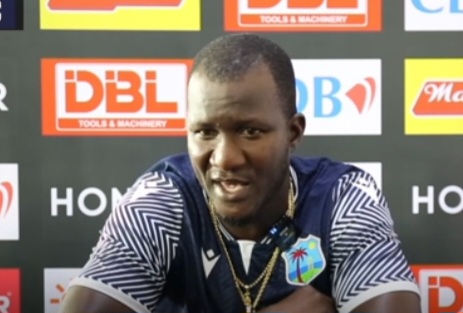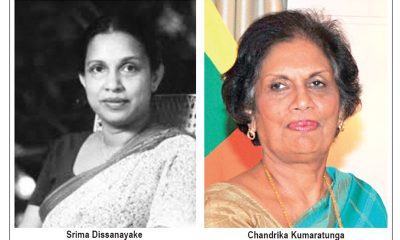Sports
Sammy calls 2-1 series loss ‘moral victory’ on turning tracks in Sri Lanka

West Indies head coach Daren Sammy has declared a “moral victory” for his side in the aftermath of the 2-1 T20I series defeat to Sri Lanka, and questioned the wisdom of the home side pivoting to turning tracks for the final two games, both must-wins for Sri Lanka.
In a fairly scathing assessment, Sammy argued that while the next T20 World Cup – in 2026 – was going to be co-hosted by Sri Lanka, such turning tracks would not be the norm with the ICC having primary input over the curation of the wickets.
“For us, to see the last two games, and the nature of the wicket from what it was at the start, I thought we actually won the contest,” Sammy said following the third T20I which Sri Lanka won by nine wickets. “Because we were the away team and in conditions set before us, we challenged them with a squad that was not our full squad, and they had to react to that.
So I told the guys, ‘yes, when the World Cup comes we won’t get these conditions – the ICC will make sure the pitches are good’. So it was a moral victory for us from the first game to the second game.”
While Sri Lanka may no doubt contest Sammy’s views, it wasn’t long ago that many within Sri Lanka’s camp were themselves clamouring for more batter friendly pitches. The calls had followed Sri Lanka’s dismal display in the 2023 World Cup in India, where their batters struggled to match the attacking approach of the top sides. This plan seemed to have taken root, to a fair amount of success, in the early part of the year where high scores were seen more frequently – particularly during the series against Afghanistan where Sri Lanka narrowly failed to chase down a target of 210.
Fast forward to the present, and Sri Lanka have just enjoyed their first-ever T20I bilateral series win against West Indies, which itself followed an ODI series win against India. Both triumphs have, however, taken place on turning tracks, which has brought up the uncomfortable question: are short-term results being prioritised in place of long-term gains?
Sri Lankan captain Charith Asalanka – who had been one of those calling for better batting tracks – doesn’t think so, as he instead opted to focus on Sri Lanka’s strengths, in this case their spin bowling.
“Sri Lanka’s strength has always been spin, and we still believe that it’s with spin that we will be able to win the most,” he said following Sri Lanka’s win in the third T20I. “So we made pitches to support that strength. When that’s working for us, I think it’s a lot easier for us to win.”
Asalanka’s point is a valid one in many ways. In Maheesh Theekshana, Wanidu Hasaranga and Dunith Wellalage. Sri Lanka boast a spin attack that would be the envy of most sides in the world, and so playing to those strengths makes sense. Sammy, though, believes this could be to the detriment of their fast-bowling contingent.
“When you have pacers, like the two slingers (Nuwan Thushara and Matheesha Pathirana) not getting an opportunity to bowl on good wickets, when the true test comes that’s where you really test your team.
“I mean, there’s home advantage, but what good does that make for the development of your squad, especially your fast bowlers, in being able to bowl and have an impact on the game?”
Sammy’s point holds some merit. In the final T20I, both Pathirana and Thushara bowled just two overs each, with the former being introduced as a seventh bowling option – after both part-time spinners Asalanka and Kamindu Mendis. In contrast, in Sri Lanka’s series win earlier in the year against Afghanistan, only two spinners had been used in each game.
And this might be where Asalanka and Sammy perhaps can find some common ground. While Asalanka has championed Sri Lanka’s spinners, he too acknowledges that they need to bolster their fast-bowling ranks.
“We have a lot of fast bowlers on our bench. Today you saw Nuwan Thushara and Matheesha Pathirana, and they bowled well when called upon. As a team, however, we need our fast bowlers to improve a little more. Aside from those currently in the side, we need more coming in. That’s how we will be able to play well in any conditions.”
Bowling and pitches aside, one immutable fact is that Sri Lanka’s batters turned up more often than did those of West Indies. Sammy, who had stated ahead of the series that he was looking to test their squad depth, is keenly aware of the improvements that need to be made on that front.
“We came here with the T20 World Cup I think less than 20 months away. Having seen the way we played on a typical Dambulla wicket – what we expected from what all the stats said – I thought we dominated.
“We started the series with a squad looking to see the depth, and the home side had to change the whole set-up to make sure that their spinners got the advantage. Ideally, yes, our men did not respond well to the spin. However, with the mindset that we have in our team being a championship winning team, we must be able to play in different conditions. You know, by letting [our] bowlers be challenged and also our batters be challenged.”
Asalanka, for his part, had no such qualms about his batters. Indeed, the scores over the course of the West Indies T20Is indicate that Sri Lanka’s batting has been performing well – they scored at least 160 in each game – despite the nature of the tracks.
“We were expecting a spinning wicket in the first game as well, but it didn’t play as we expected,” Asalanka said. “Then in the second game it turned a lot more, but we still managed to score 162, and in this game we chased down 163 in 18 overs. I think, if you look at the scores you can’t really say it’s a bad wicket.”
But what about on better tracks? While that is a question that can only be answered definitively once Sri Lanka have to deal with such conditions, Asalanka is confident that their batting line-up is primed to deal with whatever challenges are put before them.
“As a team, our goal is that if we get a good wicket abroad, we should be able to score 200-250, but if it’s a harder wicket then we should be able to score 160-170 or in that range.
“Against India, we were chasing 200 or so, but after a good start we were unable to finish it off. Even in the last game, we were on the verge of winning but then our set batters were unable to finish the game. On pitches like this it’s important that the batter that is set, as much as possible, takes the game long or finishes it off.”
(Cricinfo)
Sports
Kithmuka anchors St. Servatius’ to draw

Forced to follow on after being dismissed for 111 runs, Risinu Kithmuka scored an unbeaten half century to anchor St. Servarius’ batting line up to force a draw to their Under 19 cricket encounter against S. Thomas’ at Mount Lavinia on Friday.
The dogged knock facing 121 balls, helped the visitor post 93 for five wickets at close.
In a match dominated by the home team, Aaron David’s century was the highlight for S. Thomas’. They posted 269 for four wickets at close on day one and declared on the overnight score.
Meanwhile at Kotahena, Mevan Dissanayake top scored with 91 runs inclusive of eight fours and three sixes for St. Benedict’s to post 295 for 9 declared against Sri Dharmaloka Kelaniya.
Results
Thomians dominate against St. Servatius’ at Mount Lavinia
Scores
S. Thomas’ 269 for 4 decl. in 73.3 overs (Jaden Amaraweera 40, Avinash Fernando 50, Aaron David 100n.o., Reshon Soloman 56; Lasindu Ramanayaka 2/87)
St. Servatius’ 111 all out 54.4 overs (Risinu Kithmuka 26, Thathsilu Bandara 20; Minon Warnasuriya 2/14, Chamash Gunawardena 2/24, Shanil Perera 3/18, Reshon Solomon 2/09) and 93 for 5 in 36 overs (Risinu Kithmuka 51n.o.; Aaron de Silva 2/30, Shanil Perera 3/23)
Bens 295 for 9 decl., Sri Dharmaloka 87/2 at Kotahena
Scores
St. Benedict’s 295 for 9 decl. in 56.4 overs (Mevan Dissanayake 91, Vihanga Rathnayake 42, Yohan Edirisinghe 31, Ayesh Gajanayake 49; Sathindu Praboda 4/98, Tharusha Mihiranga 2/66)
Sri Dharmaloka 87 for 2 in 25 overs (Senuka Pehesara 40, Kaveen Deneth 40n.o.; Ayesh Gajanayake 2/27)
by Reemus Fernando
Latest News
Subhan, Minhas star as Pakistan set up U-19 final with India

Pakistan marched into the final of the Under 19 Asia Cup with a clinical eight wicket win over Bangladesh in the rain-hit semi-final in Dubai, after a dominant bowling performance led by Abdul Subban set up a straightforward chase. The victory sets up a final clash against India, who won the first semi final against Sri Lanka earlier in the day.
Opting to field after winning the toss in the rain-reduced 27-overs-a-side contest, Pakistan made early inroads as Bangladesh slipped to 24 for 2 inside six overs. Captain Azizul Hakim offered brief resistance to steady the innings, but wickets continued to tumble at regular intervals.
Fast bowler Subhan was the standout with the ball, picking up four wickets to dismantle the middle order. From 55 for 2 in the 13th over, Bangladesh lost five wickets for just 38 runs, collapsing to 93 for 7. The lower order struggled to rebuild, and Bangladesh were eventually bowled out for 121 in 26.3 overs, with no batter able to convert a start into a big score.
In reply, Pakistan’s chase was smooth. After the early loss of opener Hamza Zahoor in the first over, Sameer Minhas anchored the innings with a composed, unbeaten 69, ensuring there were no further hiccups. He struck six fours and two sixes as Pakistan cruised to 122 for 2 with 63 balls to spare.
With this knock, Minhas took his tournament’s tally to 299 to be the highest run-getter.
Brief scores:
Pakistan 122 for 2 in 16.3 overs (Sameer Minhas 69*, Usman Khan 27; Samiun Basir 1-17) beat Bangladesh 121 in 26.3 overs (Samiun Basir 33; Abdul Subhan 4-20, Huzaifa Ahasan 2-10)by eight wickets
[Cricinfo]
Latest News
Malhotra, George fifties set up India vs Pakistan final

Vihaan Malhotra and Aaron George’s patient half-centuries helped India beat Sri Lanka in a rain-reduced game and set up an U-19 Asia Cup final with Pakistan.
It was a game where the momentum kept changing hands. India had Sri Lanka at 28 for 3 after opting to bowl. Captain Vimath Dinsara and Chamika Heenetigala hit back with a 45-run stand, but Sri Lanka soon lost 3 for 11. A 62-run stand between Heenatigala and Sethmika Seneviratne followed, but India again turned it around in the final three overs.
In reply, India were 25 for 2 as Sri Lanka sniffed a comeback. But Malhotra and George added an unbeaten 114 runs in a partnership of two halves: the first 62 runs they added took 51 balls, while the next 52 came off 36 deliveries. It was Malhotra who swung the game India’s way when he went 4, 4, 6 off Dulnith Sigera in the 13th over. Malhotra reached his fifty off 35 balls, while George took 43 balls.
India’s win was set up after their bowlers restricted Sri Lanka to 138. Kishan Singh and Deepesh Devendran struck early, while Vedant Trivedi’s direct hit ran Kavija Gamage out in the sixth over.
But Kanishk Chouhan struck twice in the 12th over, and Khilan Patel in the 13th, to force Sri Lanka to rebuild again. That brought Heenatigala and Seneviratne together. Seneviratne was the attacking of the two while Heenatigala, limping a little, was more patient. At 118 for 6 with three overs left, and with Seneviratne connecting it cleanly, Sri Lanka may have hoped to post 150. But just 20 runs amid two wickets in the last three overs applied the brakes on their scoring.
India will meet Pakistan in the final on Sunday.
Brief scores:
India Under 19s 139 for 2 in 18 overs (Vihaan Malhotra 61*, Aaron George 58*; Rasith Nimsara 2-31) beat Sri Lanka Under 19s 138 for 8 in 20 overs (Chamika Heenatigala 42, Vimath Dinsara 32, Sethmika Senevirathne 30; Henil Patel 2-31, Kanishk Chouhan 2-36) by eight wickets
[Cricinfo]
-

 Midweek Review4 days ago
Midweek Review4 days agoHow massive Akuregoda defence complex was built with proceeds from sale of Galle Face land to Shangri-La
-

 Features7 days ago
Features7 days agoWhy Sri Lanka Still Has No Doppler Radar – and Who Should Be Held Accountable
-

 News3 days ago
News3 days agoPakistan hands over 200 tonnes of humanitarian aid to Lanka
-

 News3 days ago
News3 days agoPope fires broadside: ‘The Holy See won’t be a silent bystander to the grave disparities, injustices, and fundamental human rights violations’
-

 Latest News7 days ago
Latest News7 days agoLandslide early warnings in force in the Districts of Badulla, Kandy, Kegalle, Kurunegala, Matale, Nuwara Eliya and Ratnapura
-

 News4 days ago
News4 days agoBurnt elephant dies after delayed rescue; activists demand arrests
-

 Features7 days ago
Features7 days agoSrima Dissanayake runs for president and I get sidelined in the UNP
-

 Editorial4 days ago
Editorial4 days agoColombo Port facing strategic neglect












